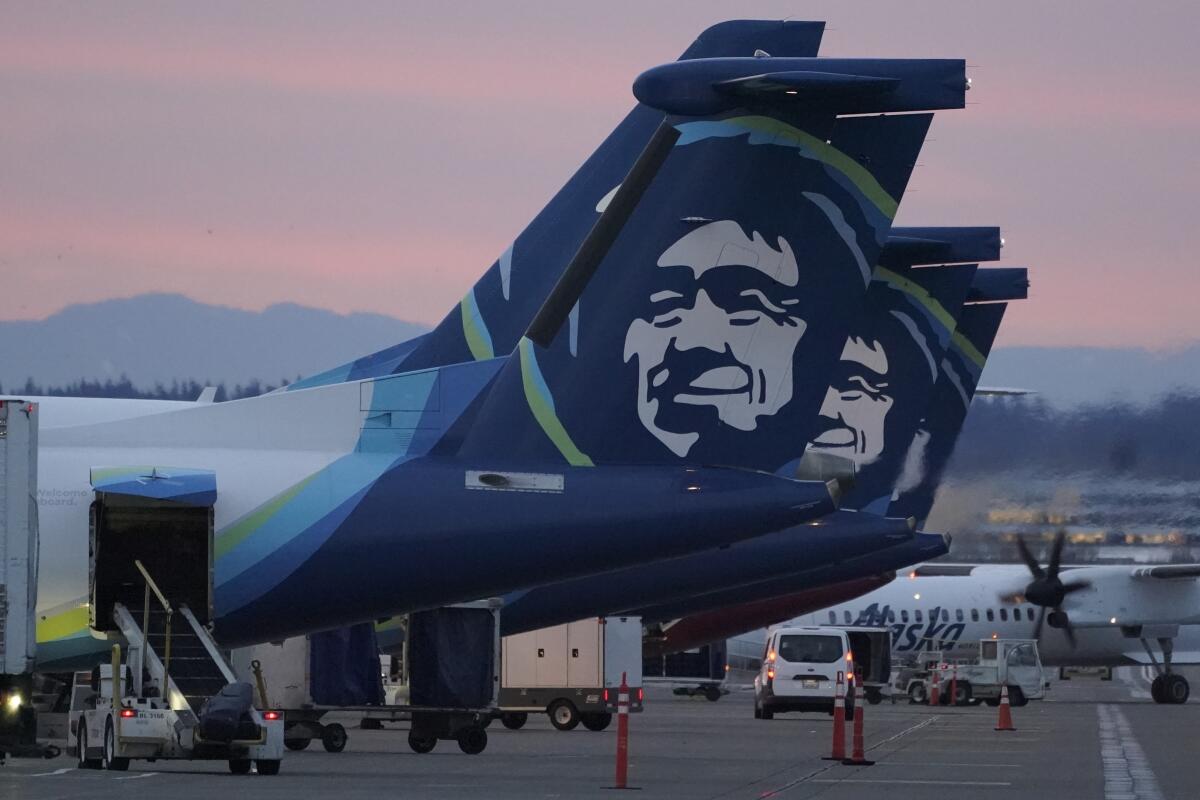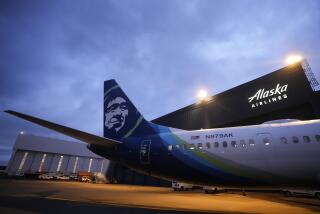‘Truly terrifying’: Investigators describe the blowout aboard an Alaska Airlines flight

Federal transportation officials launched their investigation Saturday into the cause of a sudden accident that tore open a portion of the cabin of an Alaska Airlines plane shortly after takeoff, a scene that investigators described as “truly terrifying.”
Alaska Airlines Flight 1282 was about 10 minutes into its journey from Oregon’s Portland International Airport to Ontario on Friday evening when a mid-cabin plug door abruptly “departed the airplane, resulting in rapid decompression,” said Jennifer Homendy, chair of the National Transportation Safety Board, the federal agency responsible for investigating transportation accidents.
The blowout occurred at an altitude of about 16,000 feet, Homendy said, roughly half the plane’s cruising altitude. There were 171 passengers in the plane’s 178 seats and six crew members. No major injuries were reported on the flight.
In a stroke of luck, no one was in seats 25A and 26A, the two chairs closest to the gaping hole in the plane. The force of the blowout tore both seats’ head rests off, as well as the back of seat 26A, Homendy said.
“We are very, very fortunate here that this didn’t end up in something more tragic,” Homendy said during a Saturday night news briefing at Portland International Airport. Had the accident occurred later in the flight, she said, the consequences could have been devastating.
“Think about what happens when you’re in cruise,” she said. “Everybody’s up and walking. Folks don’t have seat belts on. They’re going to restrooms. The flight attendants are providing service to passengers. We could have ended up with something so much more tragic.”
That said, she added, “I imagine this was a pretty terrifying event. We don’t often talk about psychological injury, but I’m sure that occurred here.”
Investigators are also seeking a key player in the incident: the plug door.
Radar evidence indicates that the plug door — a feature that fits into a door frame in the airplane’s body, sealing the exit from the inside — may have landed near Barnes Road and Route 217 in greater Portland’s Cedar Hills neighborhood.
“If you find that, please, please contact local law enforcement,” Homendy said. “It would be a help to us incredibly for our investigation.”
Leads on the door, as well as photographs and videos from inside the airplane, can be sent to witness@ntsb.gov, she said.
Homendy said investigators will direct special attention to the mid-cabin door on the Alaska Airlines Boeing 737 Max 9 aircraft, a new plane put into service Nov. 11, she said.
She said the aircraft was certified for up to 189 passengers, but Alaska Airlines opted for fewer seats. This did not require the commercial airline to have a functioning emergency door at that location on the aircraft. Instead, Boeing fitted the aircraft with a plug door.
“This mid-cabin door plug — one on the left and one on the right — are not operational,” Homendy said. “What you would see as a passenger is a window and just part of the cabin; you would not see those as doors unless you were outside of the aircraft.”
Homendy said federal aviation investigators will look at everything related to the aircraft including maintenance records, the pressurization system and components around the door such as bolts and hinges. The second mid-cabin plug door on the plane will play a vital part in the investigation, she added, as it will allow investigators to compare the two doors.
“At this stage everything is in,” she said. “We go very broad. Nothing is excluded.”
The Federal Aviation Administration has ordered airlines to temporarily ground some Boeing 737 Max 9 jets.
“The FAA is requiring immediate inspections of certain Boeing 737 Max 9 planes before they can return to flight,” FAA Administrator Michael Whitaker said. “Safety will continue to drive our decision-making as we assist the NTSB’s investigation into Alaska Airlines Flight 1282.”
The FAA’s airworthiness directive will affect approximately 171 airplanes worldwide, including 65 Alaska Airlines planes, as the investigation continues, officials said. The directive, which disrupted hundreds of flights, came hours after the airline had already ordered its planes grounded.
United has temporarily suspended service on all 79 of its Boeing 737 Max 9 aircraft to conduct inspections required by the FAA. The airline said in a statement that it is “working with the FAA to clarify the inspection process and the requirements for returning all MAX 9 aircraft to service.”
Operators will be required to inspect aircraft before further flights, according to the FAA directive. The required inspections take about four to eight hours per aircraft.
Alaska Airlines Flight 1282 had left Portland International around 5 p.m. headed toward Ontario.
The plane turned around and safely landed back in Portland.
FlightAware, a public airplane tracker, listed the total flight length as 35 minutes. The jet was traveling 440 mph when it was forced to turn around, according to the tracker.
A video posted to TikTok by a passenger on the flight showed a panel on the left side of the plane missing, with insulation foam visible. Oxygen masks were deployed from the ceiling. Passengers said they first heard a loud boom.
“The oxygen masks dropped down, and I look to my left to hear and see wind blasting, with a piece of the wall gone,” Elizabeth Le told KTLA-TV Channel 5. “There was no one in the window seat, but a mom and her teenage son were sitting [on] the aisle.”
“I looked up and saw that the son’s shirt was completely off and his skin was very red,” Le told the station.
Another passenger said on X, formerly known as Twitter: “I was right across from it; it was scary as hell.”
A TikTok user who was on the flight shared her experience, saying she was asleep when the plane suddenly dropped in altitude, prompting the oxygen masks to drop down. She said she heard passengers screaming.
“It was just so scary; no one knew what was happening,” she said.
Sara Nelson, president of the Assn. of Flight Attendants, which represents 50,000 members, praised the crew working Alaska Airlines Flight 1282 and said one flight attendant suffered minor injuries after an “explosive decompression at a window/plugged door.”
“Last night’s incident could have been worse, but flight attendants and pilots of Alaska 1282 ensured all passengers and crew arrived safely back on the ground,” Nelson said.
She said the union supported the temporary grounding of the Boeing Max 9 aircraft fleet.
“This is a critical move to ensure the safety of all crew and passengers, as well as confidence in aviation safety,” she said. “Lives must come first always.”
Boeing struggled with problems with its 737 Max 8 series. The Max 8 was grounded worldwide between March 2019 and December 2020 after 346 people died in two similar crashes that included Lion Air Flight 610 on Oct. 29, 2018, and Ethiopian Airlines Flight 302 on March 10, 2019.
The crashes were caused, investigators determined, by changes Boeing made that distinguish the 737 Max 8 from its predecessors.
To handle a longer fuselage that could fit more passengers, Boeing put larger, stronger engines on the plane. Those engines had to be moved forward on the wings because they didn’t fit in the same places as the old, smaller engines. But the new placement could cause the plane to pitch up. To counteract that, Boeing added software called the Maneuvering Characteristics Augmentation System, or MCAS, to automatically push the plane’s nose back down.
Regulators determined that a faulty sensor in the planes triggered the software system to nosedive under certain conditions, defying pilots’ efforts to regain control of the plane.
After 20 months of investigations, upgrades and tests, regulators cleared the plane to fly passengers again in 2021.
The FAA is also investigating the incident.
Robert Ditchey, an aviation expert and former executive at numerous airlines, said the situation with Flight 1282 could have been a lot worse had the aircraft been traveling at a higher altitude.
“The pressure differential between outside and inside is much higher when you’re at a cruising altitude, and they were halfway up,” Ditchey said. “At 30,000 feet, the partial pressure of oxygen is so low that you only have about a minute to survive at that altitude, so not only could people have been blown out of the airplane but some people might have had some problems with the low oxygen levels.”
Ditchey suspects that the failure of the plug door is not related to metal fatigue because the plane is new.
Ditchey said federal investigators will put special attention on the plug door to determine what caused it to fail. He said they’ll probably look at what held the door in place and whether there were any issues related to missing bolts, improper-sized bolts or over-torqued bolts.
“I suspect they’ll know the cause very quickly,” he said. “And, furthermore, not every airline has the plug door in that location of the aircraft.”
Rep. Norma Torres (D-Pomona), whose district includes Ontario International Airport and who serves on the House appropriations subcommittee on transportation, housing and urban development, sent a letter to Whitaker demanding to know how the FAA proposes to keep travelers safe.
“This incident endangered the lives of 177 souls on board Alaska Airlines flight 1282 and the thousands of others who may be in harm’s way on similar planes or by whose travel plans were disrupted by the precautionary groundings that Alaska Airlines has taken,” Torres wrote in her letter. “America has long held the record of having the safest airspace and flight protocols in the world. That said, Boeing’s track record, along with the FAA’s safety oversight in recent years, has raised serious, warranted concerns for the flying public.”
In her letter, Torres demanded answers to a list of questions such as what caused the paneling to come off and how widespread the issue was. She also noted that the FAA last month called for additional inspections of the 737 Max planes after reports of a possible loose bolt in the rudder control system and asked what the follow-up reports found.
Alaska Airlines Chief Executive Ben Minicucci said in a written statement that its fleet of 65 Boeing 737 Max 9 aircraft would be returned to service only after completion of full maintenance and safety inspections.
“We anticipate all inspections will be completed in the next few days,” Minicucci said. “My heart goes out to those who were on this flight — I am so sorry for what you experienced. I am so grateful for the response of our pilots and flight attendants.”
More to Read
Sign up for Essential California
The most important California stories and recommendations in your inbox every morning.
You may occasionally receive promotional content from the Los Angeles Times.












